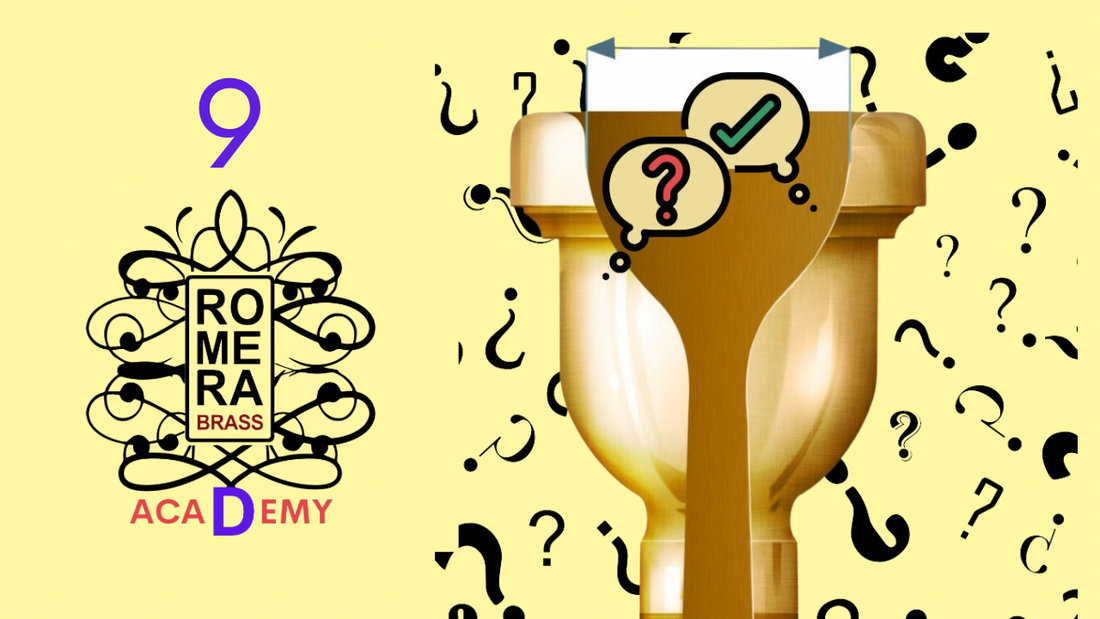
9. Where do we sizes the inside diameter of the rim of our mouthpieces?
Share
NOTE: Transcription of the text of the video, you can translate it into other languages with the Google translator
In the previous entry on mouthpieces (nº8) we talked about why the sizes of the mouthpieces of the different brands do not coincide even though they are the same size.
We saw that the main reason is that the shape of the inner ringm is always rounded or semi-rounded, which makes it very difficult to measure at this point.
For this reason, each manufacturer takes the measurement of the inside diameter of the rim in a different place and, for this reason, there are so many mismatches and problems in this regard. If you want to see the full entry you can do it here.
Today we are going to see where we take the sizes of the inner diameter of the rim in Romera Brass and why we do it in different places depending on the model of the mouthpiece.
First of all, I would like to tell you why I go against the current and sometimes my measurements do not match those of other brands.
The truth is that it would have been much easier to put the measurements that other manufacturers put but, although it was a difficult decision to make, from the beginning I was very clear about what I had to do, and this was to give the correct information and the measurements in the exact site.
But what problems and situations did I have to consider before putting these measures in place?
The first problem I encountered that I had to reflect on was in relation to the shape of the rim.
As you can see in the examples that I show you in the video that you will find at the end of this entry, when we change the shape of the rim, the sizes of the inner rim diameter also changes even if it is taken at the same point.
So, depending on the shape of the ring, do I have to put different measurements of the inner rim?
Honestly, it would be a situation that would make no sense, apart from chaos!
How could I solve this first challenge?
Luckily no matter how rounded the rim is, there is always a maximum diameter that we can manufacture, and it is in the center of this diameter, at that exact point, where I decided to take the inner rim of the diameter of the ring of my mouthpieces. At the maximum rounding that can be made a rim according to the inner diameter of the mouthpieces.
But the solution to this first problem led me to consider a second challenge to solve. What if the inside diameter of the hoop is larger or smaller? Can the sizes be taken at the same point? This is what happens with the mouthpieces of the different instruments.
Seeing the explanatory examples that are in the video you will find below, it will be much easier for you to understand why the solution was to take the measurements in different places depending on the internal diameter of the mouthpieces.
So that, Depending on the instrument, we place the sizes of the inner rim in a different place.
In Romera Brass mouthpieces, the inner rim diameter of the rim is always taken at the following points:
- Trumpet and horn: -2 mm
- Trombón y euphonium: -3mm
- Tuba: -4mm
As you can see then, all my decision on where to take the measurements of the inner ring is based or conditioned by the shapes and the inner rim diameter.
The questions that musicians ask me in relation to the sizes of the inner diameter of the rim are recurring, so today I am happy to be able to talk to you about this subject that you will understand much better by watching the following video in which I explain everything to you! detail with very visual practical examples and very descriptive and explanatory images!
Finally, remind you that on our website www.romerabrass.com within each of the pages of the different instruments you will find a table of equivalences in which you can find, simply by clicking on a link, the real measurements of other brands to know exactly how big your mouthpiece is in relation to the new Romera Brass.
The sizes of the inner rim that I give for other brands are not the same that the manufacturer puts in its catalog, but I give the measurement at the same point where I take the sizes of my mouthpieces, in order to have a more precise equivalence with the other brands. .
In the next entry I will show you how we take the measurements of our mouthpieces and other brands in the three-dimensional measuring machine, to know exactly what sizes they have (taken of course at the exact point).
See you in the next video!
I look forward to your comments, greetings and lots of music!
